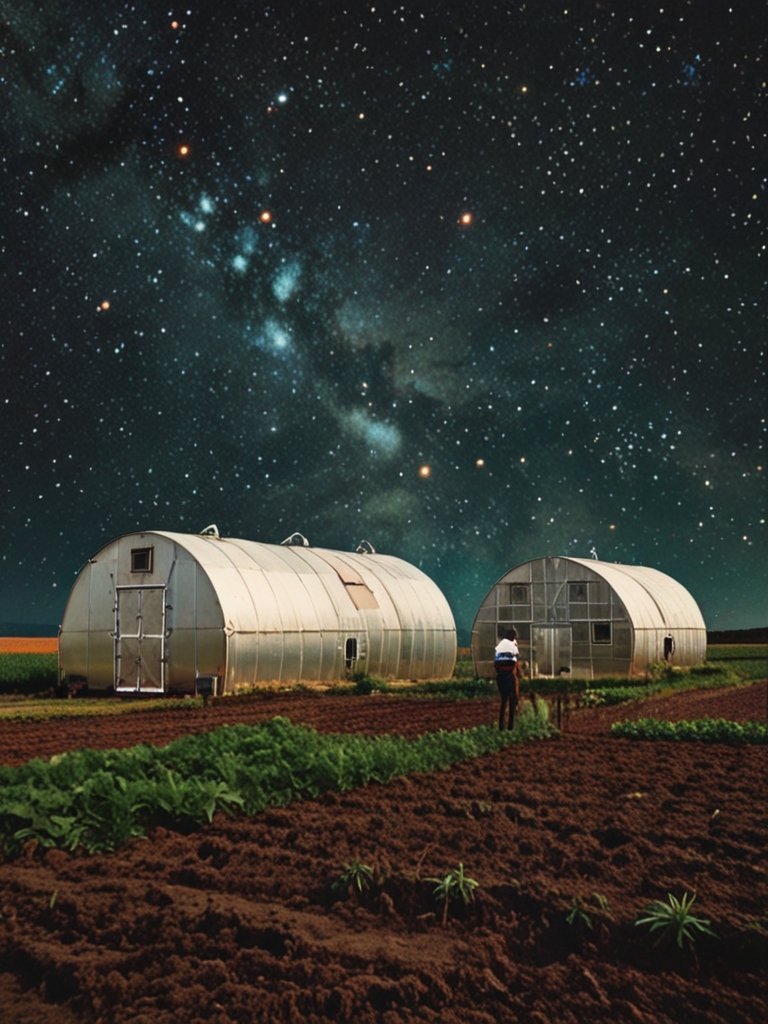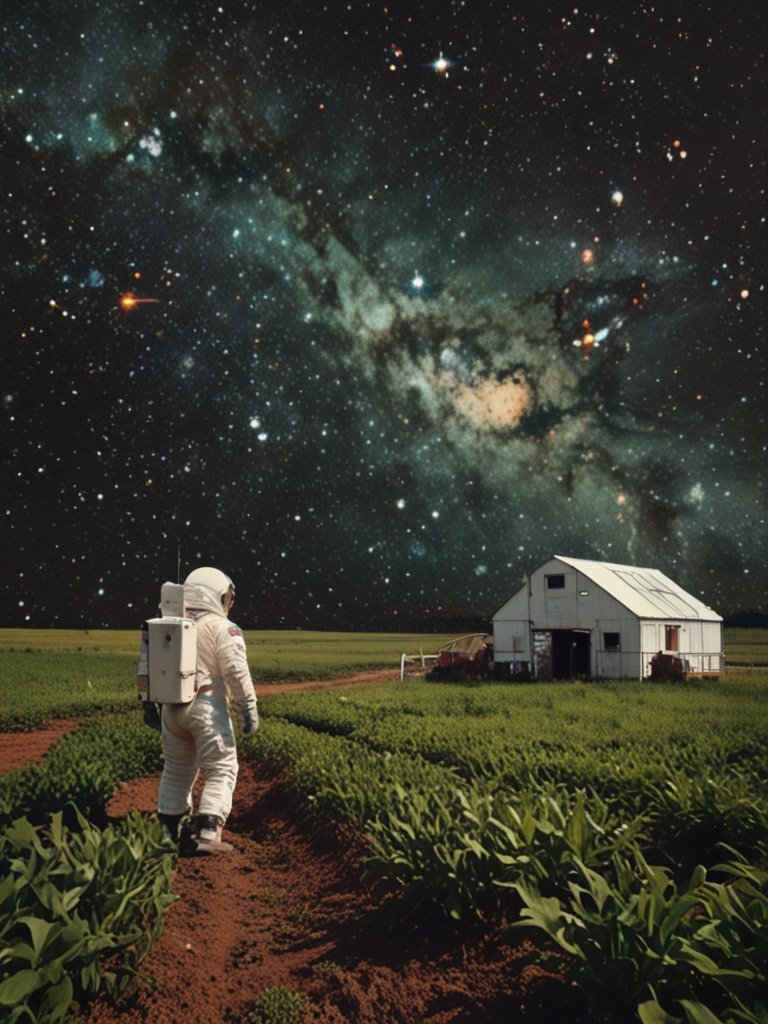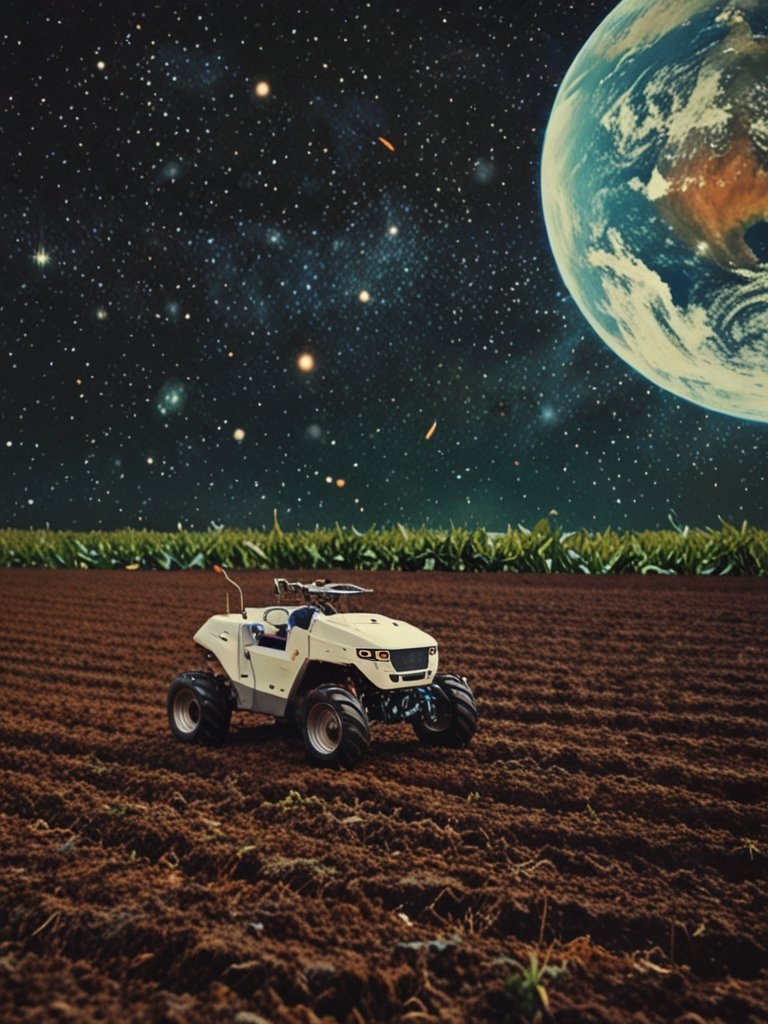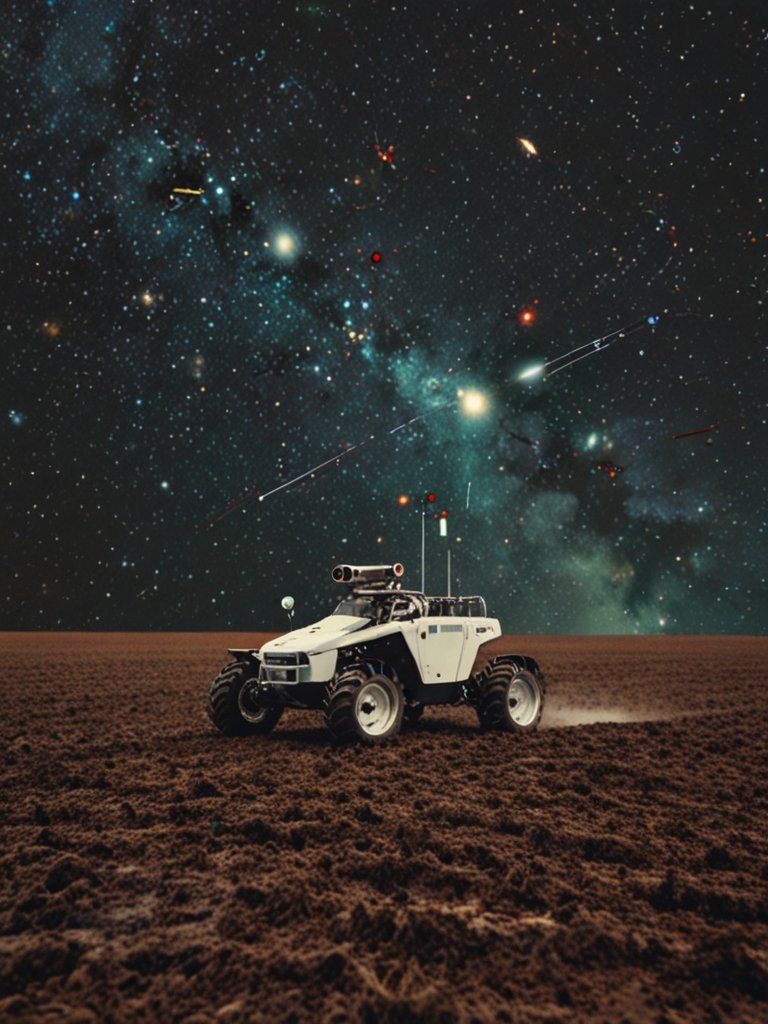Farming in the Final Frontier: The Future of Agriculture in Outer Space
October 27, 2024 | by alwaled

Introduction to Space Farming
The exploration of outer space has expanded significantly over the last few decades, raising the question of how humanity will sustain itself during long-duration missions. As human beings venture beyond Earth, the necessity for sustainable agriculture in space becomes increasingly apparent. Space farming, or the practice of cultivating crops in extraterrestrial environments, is not only integral for supplying food for astronauts but is also a crucial element in the potential colonization of other planets, particularly Mars and the Moon.
Growing food in microgravity environments presents a unique set of challenges. The absence of gravity affects plant growth, nutrient absorption, and water distribution, making traditional farming techniques inapplicable. Moreover, the limited space available in spacecraft or habitats necessitates the development of innovative vertical farming methods and hydroponics, which rely on nutrient solutions rather than soil. Additionally, the varying radiation levels in outer space could potentially harm plant growth and health, urging researchers to devise protective strategies for crops.




Technological advancements play a vital role in addressing these obstacles. For instance, researchers are exploring the use of genetically modified organisms (GMOs) that can withstand the harsh conditions associated with space travel. Furthermore, advancements in artificial lighting and automation have the potential to streamline the farming process, allowing for efficient photosynthesis and growth in controlled environments. Moreover, systems capable of recycling water and waste are fundamental, ensuring that resources are maximized and sustainability is maintained.
As interest in space exploration continues to grow, the importance of space farming cannot be overstated. It not only supports the health and well-being of astronauts during long missions but also lays the groundwork for future human settlement beyond our planet. The journey toward effective and sustainable agricultural practices in outer space is both an exciting and essential frontier of research and innovation.




The Science Behind Space Agriculture
Space agriculture presents unique challenges and opportunities for growing plants beyond Earth. A fundamental aspect of cultivating crops in space involves employing innovative methods such as hydroponics and aeroponics. Hydroponics is a soilless growing system where plants receive nutrients through a nutrient-rich water solution. This method offers a significant advantage in a microgravity environment as it eliminates the need for soil, simplifying the transport of agricultural systems to space. Additionally, hydroponics allows for precise control over nutrient delivery, which is crucial for optimizing plant health aboard spacecraft.
Aeroponics, on the other hand, is another advanced soilless technique that involves spraying nutrient solution directly onto plant roots suspended in air. This method not only conserves water but also promotes faster growth rates due to enhanced oxygen availability to the roots. Both hydroponics and aeroponics have been tested on the International Space Station (ISS), highlighting their potential for sustainable food production during long-duration space missions.




Light is a critical factor in plant growth, particularly in the distinct environment of space where natural sunlight is limited or inconsistent. Astronauts utilize specialized LED lighting systems to simulate natural sunlight and provide plants with the right spectrum of light for photosynthesis. By adjusting the light spectra, astronauts can optimize growth conditions, tailor light exposure to different growth stages, and encourage the production of essential plant hormones. This flexibility is essential for ensuring that crops can thrive despite the constraints of space.
The effects of microgravity on plant biology also play a vital role in space agriculture. Research has shown that microgravity can influence plant morphology, nutrient allocation, and growth patterns. Understanding these unique biological responses is instrumental in developing strategies that will foster plant health and productivity in extraterrestrial environments. As we continue to explore the cosmos, the science of space agriculture remains a promising frontier that holds the potential to sustain future space missions and even colonization efforts.




Current Experiments and Innovations
The exploration of agriculture in outer space has garnered significant attention, particularly with the increasing capability for long-duration space missions. Current experiments, particularly those conducted on the International Space Station (ISS), serve as a foundational platform for understanding how plants can grow in microgravity. One notable innovation is the Veggie plant growth system, which has been instrumental in studying plant growth under unique conditions. The Veggie system utilizes LED technology to provide the necessary light spectrum for photosynthesis and has successfully grown a variety of crops, including lettuce and radishes. Through careful monitoring of growth patterns and development, researchers have gained insights into how plants adapt biologically to a microgravity environment.
In addition to Veggie, advancements in bioregenerative life support systems are being explored to address the sustainability of long-term space habitation. These systems aim to create a self-sustaining ecosystem where plants can grow using waste products as nutrients, thereby closing the loop on resource consumption. For example, experiments involving the use of hydroponics and aeroponics in space have shown promising results, enabling efficient water use and nutrient delivery while minimizing the need for soil. The research has highlighted the potential for these innovative agricultural techniques not only to support crewed missions but also to prepare for the eventual colonization of other celestial bodies, such as Mars.




Moreover, the findings from these experiments extend beyond just enhancing plant growth in space. They provide critical information about the physiological stress responses of plants when subjected to spaceflight conditions, including radiation exposure and altered gravity. This knowledge can inform the development of resilient crop varieties that could thrive in both extraterrestrial environments and challenging conditions on Earth. Overall, the ongoing research and innovation in space agriculture are crucial for ensuring food security as humanity ventures further into the cosmos.




Challenges of Space Farming
Space farming is an innovative venture that seeks to address the growing concern of food security in environments beyond Earth. However, it is fraught with a multitude of challenges that can hinder successful agricultural practices in outer space. One of the most pressing issues is the limited availability of resources. In outer space, the lack of natural water sources imposes a critical constraint on irrigation practices essential for crop cultivation. Moreover, the nutrient-rich soil necessary for plant growth is often not present, requiring astronauts and researchers to devise methods to recycle waste materials or utilize specialized growth media that can substitute for traditional soil.
Another significant challenge is the risk of contamination, both from off-world and on-world sources. The closed ecosystem of a spacecraft or a space station creates a unique environment where harmful bacteria or pathogens could proliferate uncontrollably. Maintaining a sterile environment for crops is crucial to prevent crop failure and ensure astronaut health. Researchers are actively exploring various containment and sterilization techniques to mitigate these risks, including the use of closed-loop systems that limit exposure to outside contaminants.




The psychological effects on astronauts must also be considered when discussing the challenges of space farming. Prolonged isolation and limited interaction with Earth can lead to mental health issues, which may impact productivity and overall well-being. Cultivating plants can serve as a therapeutic activity, contributing positively to astronauts’ mental states. To harness this potential, scientists are studying the benefits of incorporating green spaces and farming activities in astronaut routines, thereby fostering a sense of normalcy and enhancing morale during extended missions.
In conclusion, while space farming presents unique challenges including resource limitations, contamination risks, and psychological effects, research and technological advancements continue to pave the way for sustainable agricultural practices in outer space. Addressing these challenges is paramount as humanity looks to explore and settle in new frontiers.




Sustainable Agriculture Practices for Space
The exploration of sustainable agriculture practices in outer space is vital for the success of future space colonies. With limited resources and a harsh environment, it becomes paramount to adapt methods that ensure longevity and sustainability. One key approach is the implementation of closed-loop systems. These systems recycle nutrients and resources, creating a self-sustaining environment that minimizes waste. In such a system, organic waste produced from plants and animals can be converted back into usable nutrients, thus reducing the need for external inputs and creating a resilient ecosystem.
Another important aspect of sustainable farming in space is waste recycling. Given the constraints of a space environment, it is crucial to repurpose waste materials effectively. Organic waste can be composted and used to enrich the soil, while inorganic materials can be recycled to serve different purposes within the agricultural system. This cycle not only minimizes pollution but also maximizes the utility of available resources. Techniques such as vermicomposting, which utilizes worms to break down organic matter into nutrient-rich soil, could be particularly effective in maintaining soil health.




Furthermore, energy-efficient farming technologies will play a crucial role in sustainable agriculture in space. Utilizing renewable energy sources such as solar or wind power can significantly reduce dependency on nonrenewable resources. Vertical farming and hydroponics are ideal for space farming as they require less land and water than traditional farming methods. These technologies facilitate the growth of crops in controlled environments where variables such as light and nutrient levels can be closely monitored and adjusted.
As we envision future settlements beyond Earth, integrating these sustainable agriculture practices will be essential for cultivating food, conserving resources, and building self-sufficient communities. This focus on sustainability not only supports the immediate needs of space inhabitants but also ensures the environmental integrity of extraterrestrial habitats. Sustainable practices will be at the forefront of agriculture in the final frontier, ultimately enabling humans to thrive in outer space.




Case Studies: Successful Space Farms
As humanity seeks to expand its presence beyond Earth, the concept of agriculture in outer space has gained significant traction, evidenced by a myriad of innovative projects. One notable example is the Mars Society’s Mars Greenhouse. Designed to explore sustainable food production on Mars, this project employs advanced hydroponic and aeroponic systems. By utilizing minimal water and nutrient resources, the Mars Greenhouse demonstrates a viable model for cultivating crops in Martian conditions. The research outcomes indicate that certain plants, such as lettuce and radishes, can successfully germinate and grow when subjected to the challenging Martian environment. This endeavor not only showcases technological ingenuity but also reinforces the importance of robust agricultural systems for potential Martian inhabitants.




In addition to the Mars Society’s efforts, various international space agencies have undertaken agricultural experiments in microgravity. NASA’s Veggie project aboard the International Space Station (ISS) stands out as a pioneering initiative. This venture focuses on cultivating crops in a controlled environment, with lettuce being the first crop grown and consumed by astronauts in 2015. The Veggie system incorporates LED lighting and a soil-less growing medium to maximize growth efficiency and quality. Results from NASA’s experiments reveal that plants grown in space show comparable growth rates and flavors to those grown on Earth, emphasizing the feasibility of space farming. The success of the Veggie project has laid the groundwork for future studies, aiming to establish long-term food production in space habitats.




Moreover, China’s Tiangong space station has also initiated its agricultural research program. In 2021, astronauts successfully grew rice and other plants in the station’s controlled environment. This initiative not only contributes to understanding the biological reactions of plants in microgravity but also enhances our knowledge regarding closed-loop life support systems essential for future long-duration space missions. These case studies illustrate the increasing momentum and potential advancements in extraterrestrial agriculture, indicating a promising future for sustainable food sources beyond our planet.




The Role of AI and Robotics in Space Agriculture
The integration of artificial intelligence (AI) and robotics into space agriculture presents a transformative opportunity for enhancing efficiency and resource management in extraterrestrial farming environments. As humanity ventures deeper into the cosmos, the challenges associated with farming in space become increasingly complex. Here, AI and robotics can play pivotal roles in ensuring sustainable agricultural practices that are vital for long-term space missions.
Autonomous farming systems, which leverage AI algorithms and robotic technologies, are designed to operate with minimal human intervention. These systems can monitor crop health, optimize growth conditions, and manage resources such as water and nutrients with extraordinary precision. By employing sensors and data analytics, AI can analyze environmental variables, predict crop needs, and adjust parameters accordingly to maximize yields in the unique conditions of space, such as reduced gravity and varying light conditions.




Robotic caretakers further enhance this efficiency by performing routine tasks such as planting, watering, and harvesting. These robots can be programmed to navigate complex agricultural environments, perform task repetitions with high accuracy, and react swiftly to changing conditions. Such adaptability is crucial given the resource constraints inherent in space missions, where the supply of water and soil amendments is limited and must be carefully managed.
Additionally, advancements in AI technology facilitate predictive analytics, allowing for better decision-making during crop management. This can include identifying optimal planting schedules and crop rotations that align with the peculiarities of space habitats. The synergy of AI and robotics in space agriculture not only streamlines operations but also yields deeper insights into crop performance under extraterrestrial conditions, paving the way for future innovations that could redefine agriculture beyond Earth.




Future Prospects: Colonizing Other Planets
As humanity progresses toward the colonization of other planets, particularly Mars, the future of agriculture in outer space emerges as a critical area of focus. Understanding the implications of growing food in extraterrestrial environments presents both challenges and opportunities. One of the foremost considerations is the creation of sustainable agricultural models that can function under conditions vastly different from those on Earth. The unique environmental factors, such as lower gravity, reduced sunlight, and varying atmospheric compositions, will necessitate innovative approaches to farming.
Hydroponics and aeroponics are two methods that are particularly well-suited for off-world agriculture. These soil-less farming techniques have been successfully tested in controlled environments on Earth and offer promising prospects for cultivating crops in limited spaces, using minimal water, and with less dependence on traditional soil-based farming. Additionally, vertical farming systems could optimize space and ensure a continuous supply of fresh produce in the confined environments of spacecraft and colonies.




Furthermore, the cultivation of genetically engineered crops capable of thriving in alien conditions may also play a significant role. Advances in biotechnology could lead to the development of plants that can withstand extreme temperatures and nutrient-deficient soils, which would be essential for food security on planets like Mars where the existing soil lacks vital nutrients.
International collaboration will be pivotal in addressing these challenges. Various space agencies, private companies, and research institutions are likely to join forces to pool resources, share knowledge, and accelerate agricultural innovations. Such partnerships could enhance the development of techniques and technologies, ensuring that future colonists have adequate food supplies and can sustain human life in an extraterrestrial environment.




Ultimately, as we look towards the stars, the evolution of farming in space will be fundamental to humanity’s future beyond Earth. The successful colonization of other planets will depend not only on our ability to adapt to new environments but also on fostering a spirit of cooperation amongst the global community to tackle these pressing challenges.




Conclusion: A New Era of Agriculture
As we stand on the precipice of a new era in agriculture, it becomes increasingly clear that developing viable farming systems for extraterrestrial environments is not merely a scientific endeavor; it is a moral imperative for the sustainability of humanity. The challenges of food production in space necessitate innovative approaches that integrate advanced technologies with our understanding of agriculture. Key points discussed highlight that for long-term space habitation, efficient resource management, such as the utilization of hydroponics and aeroponics, will be crucial. These methods hold the potential to yield nutritious crops while conserving water and space, which is essential in an environment where resources are limited.
Moreover, the significance of research in astrobiology and astrobotany cannot be overstated. Understanding how plants can adapt and thrive in microgravity environments offers insights that extend beyond the boundaries of Earth. This knowledge opens avenues for creating ecosystems that can support human life during long-term missions to planets such as Mars or for establishing colonies on the Moon. The collaborative efforts between scientists, engineers, and agricultural experts play an indispensable role in designing these futuristic farming systems, ensuring a sustainable food supply wherever humans may venture.




Furthermore, as we explore the potential for farming beyond Earth, it invites us to rethink our agricultural practices here on our own planet. The innovations born from necessity in outer space could inspire new methodologies to enhance food security and combat climate change on Earth, thus reinforcing the interconnectedness of our agricultural futures. Thus, the implications of space farming extend far beyond the stars, reflecting a broader significance in our quest for sustainability. The future indeed holds exciting possibilities for agriculture, allowing humanity to flourish not only on this planet but across the cosmos.




RELATED POSTS
View all


